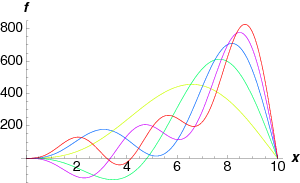10.8: Fourier-Bessel Series
( \newcommand{\kernel}{\mathrm{null}\,}\)
So how can we determine in general the coefficients in the Fourier-Bessel series
The corresponding self-adjoint version of Bessel’s equation is easily found to be (with
Where we assume that
From Sturm-Liouville theory we do know that
Let us use the self-adjoint form of the equation, and multiply with
This can be brought to the form (integrate the first term by parts, bring the other two terms to the right-hand side)
The last integral can now be done by parts:
So we finally conclude that
In order to make life not too complicated we shall only look at boundary conditions where
We thus finally have the result



